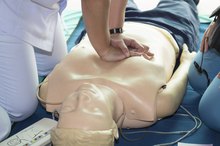Tepid Sponge Bath Procedures
A tepid sponge bath can reduce fever and stress when performed correctly. Most generally, this type of care is offered in a hospital setting to lower an elevated temperature but can be completed easily at home. "Textbook of Basic Nursing" advises that the bath must be administered for at least 30 minutes to be effective 1. Constant monitoring of the patient's body temperature is essential, so that it does not drop below normal.
Preparation
Explain to the patient what you will be doing. The bath is ineffective if the patient is nervous or frightened. Record the temperature before beginning the bath. Gather the needed supplies: bath basin, several washcloths, towels and a bath sheet. Fill the bath basin with tepid water, 80 to 90 degrees Fahrenheit. You may need to refill the basin several times throughout the bath, to prevent the water from becoming too cool.
Soak four washcloths in the tepid water and wring out the excess. Place one washcloth under each of the patient's arms and one on each side of his groin. The blood vessels are close to the skin in these areas, and this will help to cool the patient more effectively. At first, the patient will be chilled by this; allow several minutes for his body to adjust to the temperature of the water.
- Explain to the patient what you will be doing.
- You may need to refill the basin several times throughout the bath, to prevent the water from becoming too cool.
Bathing
Instructions for a BD Digital Thermometer
Learn More
Sponge each of the patient's limbs for five minutes. Keeping the lower half of the patient covered, begin sponging his arms and chest. Work your way to the legs, keeping the patient covered with a towel in the areas you are not bathing. Sponge the back and buttocks for ten minutes. This time is essential to lowering the temperature effectively. Continue to monitor the patient’s temperature at intervals throughout the bath procedure. Replace the tepid water if chilled. If at any time the patient becomes chilled and begins shivering, stop the bath.
Discontinue the bath once the temperature has reached a normal level. Cover the patient with the bath sheet.
- Sponge each of the patient's limbs for five minutes.
- Work your way to the legs, keeping the patient covered with a towel in the areas you are not bathing.
Related Articles
References
- "Textbook of Basic Nursing" (9th Edition); Caroline Bunker Rosdahl and Mary T. Kowalsi; 2007
- Harvard Health Publishing. Harvard Medical School. Hemorrhoids and what to do about them. Updated February 6, 2019.
- University Health Network. Having a sitz bath at home. Updated July 2016.
- Lang DS, Tho PC, Ang EN. Effectiveness of the Sitz bath in managing adult patients with anorectal disorders. Japan Journal of Nursing Science. 2011;8(2):115-128. doi:10.1111/j.1742-7924.2011.00175.x.








